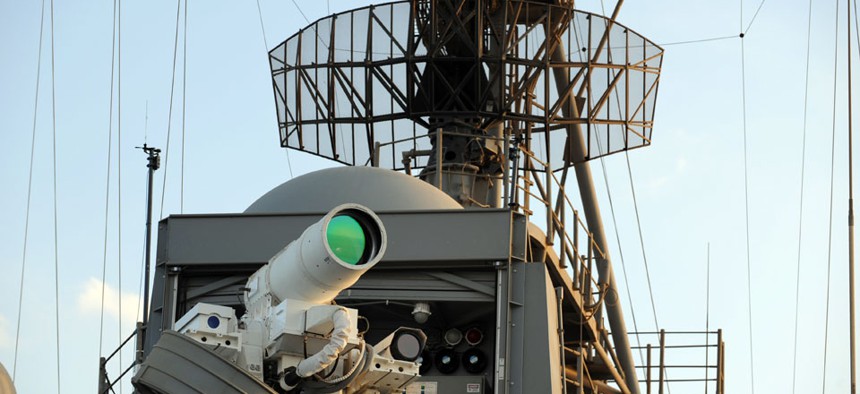A Brief History of Militarized Lasers

The Laser Weapon system aboard the USS Ponce taken Nov. 16, 2014. US Navy/AP
The Navy recently mounted a laser cannon on a ship. It's been a long time coming.
Welcome to the future: The United States Navy's laser cannons are now fully operational. On Monday, the military unveiled the all-too-boringly named "Laser Weapon System" (LaWS), a 30-kilowatt weapon perched aboard the USS Ponce in the Persian Gulf.
Like a hair dryer, LaWS can be operated on a number of power settings. On low, it can "dazzle" (the Navy's term), disrupting enemy electronics. You can imagine a captain shouting the order with dramatic glee: "Set the laser to DAZZLE!!!" Turned up high, a full blast can destroy an unmanned aircraft or punch a hole in a boat. See for yourself:
The laser is still considered a prototype, a Monday's demonstration with reporters shows it can unleash arresting force. However, under the protocols of the Geneva Convention, the use of lasers against humans is banned. The Navy intends to comply. "We will not point lasers at people," Adm. Matthew Klunder, the Navy's research chief, told reporters . And it's easy to operate. "Any of you that can do Xbox or PS4, you'll be good with this," Klunder said.
The LaWS is a 60-year-old dream in the making. Since the invention of the laser in the 1960s, military leaks and journalist reports have been speculating on the development of the laser cannon and laser weapons. Here's a quick history.
The 1960s
Popular Mechanics —that century-old compendium of everything gee-whiz—heralded the age of the laser in a 1962 issue . "Magic crystals called lasers may form the basis for a real science-fiction weapon—a 'death ray,' " the magazine informed readers.

"Scientist have tripped the light fantastic," The Washington Post exclaimed in 1962. "Nothing in recent memory has so excited physicists, engineers, industrial managers and military planners as has the potential of these extraordinary beams of light called lasers."
The Post did leave some room for doubt on the promise of laser weapons, though. "There is a healthy skepticism of the notion that lasers will prove to be the 'ultimate' or 'all-out' weapon, or indeed, an effective weapon at all," The Post wrote. But, as The Post warned, "Soviet Russia is just as hard at work at laser research as is the United States." Which assured continued research and funding.

According to From Glow to Flow: A History of Military Laser Research and Development by Robert W. Seidel , in the early '60s, the military quickly enlisted contractors work on the technology. In 1962, lasers were already a $50 million industry. "I feel as do others here that the LASER may be the biggest breakthrough in the weapons area since the atomic bomb," the head of the Army Ordnance Missile Command wrote in 1962.
But for all the money spent, weaponized laser cannons were very slow to materialize. It simply took too much power to create a beam that could pack a punch. "What the story of laser development does show is that attempts to scale lasers to very high powers have been costly, and that they have not yet produced a beam weapon for field use," Seidel wrote .
The '70s

In 1972, T he Post reported on a laser-based "eye-popper" device that would blind pilots in midair by actually destroying part of their retina.
"This strangest of weapons was dreamed up in the early sixties as a means of exploding the eyes of enemy soldiers and their officers from distances of more than a mile," reported The Post , which had obtained a copy of the classified research. "Giant pulse lasers were used to bring rabbit and monkey eyes to the boiling point, causing bleeding and actual explosion in the eye."
Development of the weapon, dubbed C-CLAW (combat laser assault weapon), continued into the '80s, according to Post archives. But the ethics of such a device were debated within the military. The Post said the weapon under development "would sweep back and forth across a battlefield blinding anyone who looked directly at it."
The '80s
Two words: Star Wars. In the 1980s, President Reagan introduced the Strategic Defense Initiative, a program to shoot down enemy missiles from space. The system would have included X-ray lasers and subatomic particle beams, among other futuristic-sounding doom devices. But the power needed to supply such weapons was prohibitive. The initiative floundered.
And as it turned out, Soviet efforts to build space lasers also amounted to nothing.

The '90s
In 1995, an update of the Geneva Conventions banned the use of blinding laser weapons internationally. The adopted language read :
It is prohibited to employ laser weapons specifically designed, as their sole combat function or as one of their combat functions, to cause permanent blindness to un-enhanced vision, that is to the naked eye or to the eye with corrective eyesight devices.
The 2000s
During the invasion of Iraq, the military deployed "low-powered" dazzler lasers "to warn or temporarily incapacitate individuals," according to a Post article from 2008 .
Marines were given approval to use a green laser whose beam can temporarily reduce a person's vision when aimed from a distance of 1,000 yards, according to the report. These "laser optical incapacitation devices" were being procured on a case-by-case basis.
As the lasers did not cause permanent blindness, they complied with the Geneva Conventions.
--
Lasers have been an essential technology for the military, but more so in the realms of missile guidance. And they have also revolutionized other industries like space travel and health care. Lasers will even pave the way for next-generation self-driving cars. But personal laser sidearms? Still science fiction.






